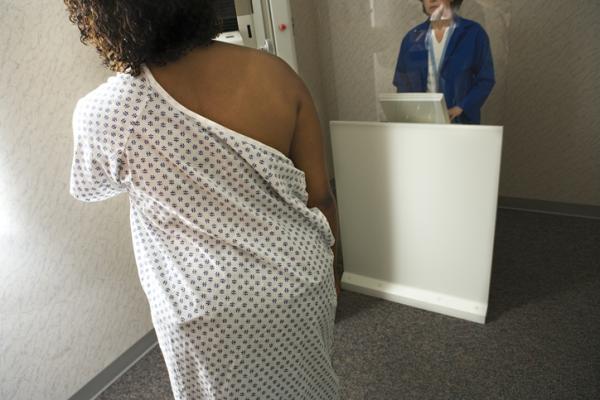
Getty Images
October 19, 2021 — If Black women begin mammography screening every other year starting at age 40, breast cancer deaths could be reduced by 57 percent compared to starting screening 10 years later — as is currently recommended by some organizations — according to analyses conducted by a modeling team that is part of the Cancer Intervention and Surveillance Modeling Network (CISNET), funded by the National Cancer Institute.
The analyses are the first to use modeling to elucidate modern breast cancer screening strategies that best achieve equity in screening outcomes and reduce mortality disparities. The research, published October 19, 2021 in Annals of Internal Medicine, suggests that a reduction in breast cancer deaths can be achieved for Black women while maintaining the same ratio of benefits to harms as occur with current general screening recommendations. Recommendations over the past two decades have not accounted for the role of racism (structural, interpersonal, or internalized) and its impact in breast cancer treatment, length of survival and deaths among Black women.
"There is an increasing focus on eliminating race-based medicine,” explains the study’s lead author Christina Hunter Chapman, M.D., MS, adjunct assistant professor in the Department of Radiation Oncology at the University of Michigan. “However, calls to end race-based medicine that ask for the immediate cessation of any discussion on race are not likely to eliminate racial disparities. Carefully selected solutions for health inequity may involve tailoring interventions to specific racial groups.”
To address this issue, CISNET developed a model using self-reported race as a proxy for who is likely to experience the effects of racism to test a range of screening strategies. The model also considered breast density, distribution of breast cancer molecular subtypes, age-, stage-, and subtype-specific treatment effects, and non-breast cancer mortality for Blacks and whites. Using all of these data, the model compared the benefits and harms of different screening strategies in Black women to those for white women screened according to the US Preventive Services Task Force (USPSTF) recommendations (biennially from ages 50-74).
“For Black women, three biennial screening strategies (beginning at age 40, 45, or 50) yielded benefit-to-harm ratios that were greater than or equal to those seen in white women who started screening at age 50,” explained Chapman. “Among those three strategies, initiating mammograms at age 40 yielded the greatest mortality reduction and reduced Black-white mortality disparities by 57 percent.”
The model the researchers used projected the lifetime impact of digital mammography under different starting ages and intervals between screenings for women who would be age 40 in the year 2020 (i.e., born in the U.S. in 1980). It compared a variety of benefits (number of years of life gained by detecting cancer early, breast cancer deaths averted and mortality reduction) to harms like undergoing a larger number of mammograms (e.g., annual vs. every other year screening) and having false positive screening results.
“Black women have higher rates of aggressive cancers at younger ages than white women, and treatments for those types of tumors are not as effective. However, even when we account for cancer subtypes, mortality is higher for black women largely due to factors that are ultimately rooted in racism,” says the study’s senior author, Jeanne S. Mandelblatt, M.D., MPH, professor of oncology and medicine at Georgetown Lombardi Comprehensive Cancer Center, and a principal investigator with CISNET.
“Therefore, in our analyses we accounted for differences in treatment attributable to racism, including access to medication, delays in treatment, dose reductions, and discontinuation of treatment -- all factors that have been shown to be sub-optimal more often in Black than white women,” she added.
“We hope this provides new information to help develop equity-focused recommendations for Black women and address a long-standing deficit in breast cancer screening guidelines,” Mandelblatt stated.
“In the future, the harms of racism in medicine may be better rectified by developing interventions that use more direct measures of racism as instead of race,” Chapman concluded. “However, using socioeconomic status alone as a proxy for race would not be appropriate in a study like ours given that racial disparities in breast cancer are observed across socioeconomic strata."
"This project highlights how CISNET modeling can provide important new data to guideline groups seeking to increase equity in cancer outcomes,” said Brandy Heckman-Stoddard, Ph.D., chief, Breast and Gynecologic Cancer Research Group at the National Cancer Institute. “It also points to the need to continue to capture data on screening practices across diverse populations."
For more information: lombardi.georgetown.edu/
Related Breast Imaging Information:
Black Women Face Three-fold Increased Risk of Triple Negative Breast Cancers
Black Women Are Receiving Inferior Breast Screening
Hologic Partners with Oprah Winfrey Network to Combat Health Disparities for Black Women
Legislation May Help Identify Breast Cancer Earlier in Certain At-risk Women
Female Breast Cancer Surpasses Lung as the Most Commonly Diagnosed Cancer Worldwide
Johns Hopkins Medicine Expert Weighs Devastating Impact of COVID-19 on Healthcare Workers


 December 17, 2025
December 17, 2025 









